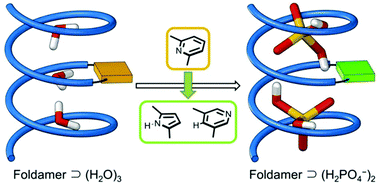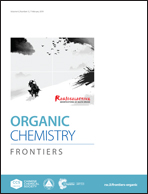Encapsulation of dihydrogenphosphate ions as a cyclic dimer to the cavities of site-specifically modified indolocarbazole-pyridine foldamers†‡
Abstract
Indolocarbazole-Pyridine (IP) hybrid foldamers have been known to adopt a helical conformation with an internal tubular cavity wherein water molecules are tightly packed via the formation of multiple cooperative hydrogen bonds. In order to develop IP foldamer-based receptors for ions and molecules other than water molecules, we herein prepare two modified IP foldamers 2 and 3 that contain a pyrrole and an inverted pyridine in the middle of the strands, respectively, instead of the original pyridine unit. Such site-specific modification significantly disrupts the hydrogen-bonding network between the entrapped water molecules and the interior of the cavity, thus allowing for binding two dihydrogenphosphate ions as a cyclic dimer inside the cavity as demonstrated by 1H NMR spectroscopy and X-ray crystal structure analysis. The crystal structures of the two complexes (H2PO4−)2 ⊂ 2 and (H2PO4−)2 ⊂ 3 are very similar to each other, with twelve hydrogen bonds between the bound dihydrogenphosphate dimer and the interior functional groups, indolocarbazole NH protons, pyridine nitrogen atoms and terminal OH protons in the helical tubular cavity.

- This article is part of the themed collection: In celebration of Julius Rebek’s 75th Birthday


 Please wait while we load your content...
Please wait while we load your content...